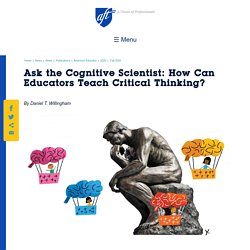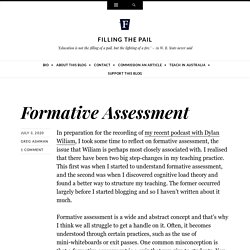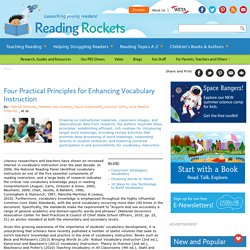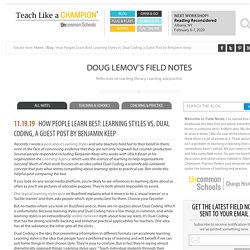

Ask the Cognitive Scientist: How Can Educators Teach Critical Thinking? By Daniel T.

Willingham How does the mind work—and especially how does it learn? Teachers’ instructional decisions are based on a mix of theories learned in teacher education, trial and error, craft knowledge, and gut instinct. Such knowledge often serves us well, but is there anything sturdier to rely on? Cognitive science is an interdisciplinary field of researchers from psychology, neuroscience, linguistics, philosophy, computer science, and anthropology who seek to understand the mind. Individuals vary in their views of what students should be taught, but there is little disagreement on the importance of critical thinking skills. Despite this consensus, it’s not always clear what’s meant by “critical thinking.” Critical Thinking Can Be Taught Planning how to teach students to think critically should perhaps be our second task. But perhaps we should not find this result terribly surprising.
Formative Assessment. In preparation for the recording of my recent podcast with Dylan Wiliam, I took some time to reflect on formative assessment, the issue that Wiliam is perhaps most closely associated with.

I realised that there have been two big step-changes in my teaching practice. This first was when I started to understand formative assessment, and the second was when I discovered cognitive load theory and found a better way to structure my teaching. The former occurred largely before I started blogging and so I haven’t written about it much. Formative assessment is a wide and abstract concept and that’s why I think we all struggle to get a handle on it.
Often, it becomes understood through certain practices, such as the use of mini-whiteboards or exit passes. Wiliam’s settled definition of formative assessment is: This does not mean that we plan for formative assessment and leave a blank space afterwards to be filled only once we have the evidence from the assessment. 1. 2. 3. Teaching and Learning Toolkit. Improving Literacy in Secondary Schools. This guidance report aims to help secondary schools improve literacy in all subject areas.

It provides seven recommendations related to reading, writing, talk, vocabulary development and supporting struggling students. Throughout the report, recommendations emphasise the importance of disciplinary literacy. Disciplinary literacy is an approach to improving literacy across the curriculum. Four Practical Principles for Enhancing Vocabulary Instruction. Literacy researchers and teachers have shown an increased interest in vocabulary instruction over the past decade.

In 2000, the National Reading Panel identified vocabulary instruction as one of the five essential components of reading instruction, and a large body of research indicates the critical role vocabulary knowledge plays in reading comprehension (August, Carlo, Dressler & Snow, 2005; Baumann, 2009; Chall, Jacobs, & Baldwin, 1990; Cunningham & Stanovich, 1997, Mancilla-Martinez & Lesaux, 2010). Furthermore, vocabulary knowledge is emphasized throughout the highly influential Common Core State Standards, with the word vocabulary occurring more than 150 times in the document. Given this growing awareness of the importance of students' vocabulary development, it is unsurprising that scholars have recently published a number of useful volumes that seek to enrich teachers' knowledge and practice in the area of vocabulary instruction.
General guidelines for vocabulary instruction. How People Learn Best: Learning Styles vs. Dual Coding, a Guest Post by Benjamin Keep - Teach Like a Champion. Recently I wrote a post about Learning Styles and why teachers held fast to their belief in them, even in the face of convincing evidence that they are not only hogwash but counter-productive.

Several people responded including Benjamin Keep who works with Ulrich Boser at his organization the Learning Agency which uses the science of learning to help organizations succeed. Much of their work focuses on an idea called Dual Coding, a scientifically validated concept that puts what seems compelling about learning styles to practical use. Ben wrote this helpful post comparing the two. If you look on any social media platform, you’re likely to see references to learning styles about as often as you’ll see pictures of adorable puppies. They’re both almost impossible to avoid. One typical learning styles quiz on Buzzfeed explains what it means to be a ‘visual learner’ or a ‘tactile learner’ and then asks people which style works best for them. Dual Coding. The Paper Rocket: Thoughts on Improving 'Hands-On' Learning - Teach Like a Champion. A couple of weeks ago, I asked my littlest what was going on in Science.

It’s her favorite class so it doesn’t take much to get some chatter going. She announced with no small amount of excitement that they were going to be building and flying rockets later that week. “Oh, cool,” I said, “Are you studying air resistance? Or aerodynamics?” That sounded super-geeky, so I re-phrased: “You know, what sorts of things might make a rocket fly better.”
“I’m not really sure,” she said, “We haven’t yet,” which was interesting because the rocket flying was just three or fours days away. 7 High-Impact Learning Strategies You Must Teach Your Students. How to Use Concept Mapping in the Classroom: A Complete Guide. Homework: How to Make It All Worthwhile - Evidence-Based Teaching.